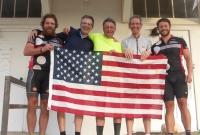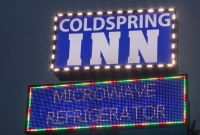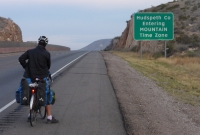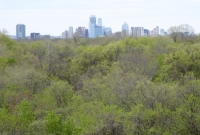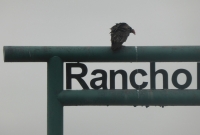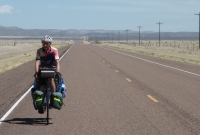It’s not often you come across Elizabeth Taylor while riding through the deserts of west Texas, nor is it somewhere you’d expect to find a Prada store – but this was a day of strange occurrences. The oddest thing of all was we got up so early we managed to break camp, wolf down mountains of bran flakes laced with creamer, suck on an avocado and be on the road by 7.35am. Even the sun hadn’t bothered to put in an appearance by then. Terry put our swiftness down to the fact that, for once, there was absolutely no-one to talk to.
We were rewarded with a tailwind which saw us fly out of Marfa, shoot past our second home at Mandos (the local Mexican restaurant) and embed ourselves onto the shoulder of the 90 as a red glow of light appeared behind us and began to cast an early glow on the mountains.
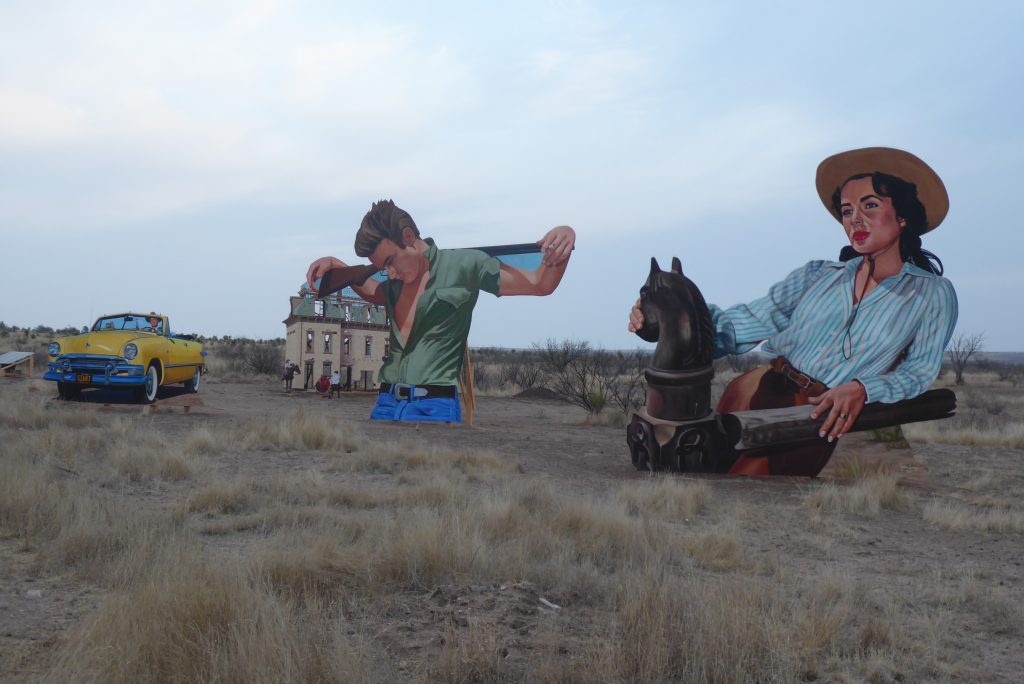
Just over seven miles west of town we saw her, leaning back on a horse rail in tan trousers, a blue striped linen shirt and cowboy hat. Towering 15 feet above the scrub she was unmistakeable with her jet black hair, red lips and confident stare, lost in thought as she stared across the valley to the Mexican border.

To Elizabeth Taylor’s left, shirt open to the stomach and a rifle slung across his shoulders stood James Dean, staring down at the dust and dirt, while a jaunty looking Rock Hudson, at the wheel of a bright yellow Ford ’51 convertible, drove past seemingly unaware of the two screen legends to his side. This ‘giant’ diorama is a tribute to the 1956 film ‘Giant’, which was shot in and around Marfa, with the main set being the Reata Mansion which depicted the Benedict ranch. There was even a mock-up of director George Stevens at his megaphone.
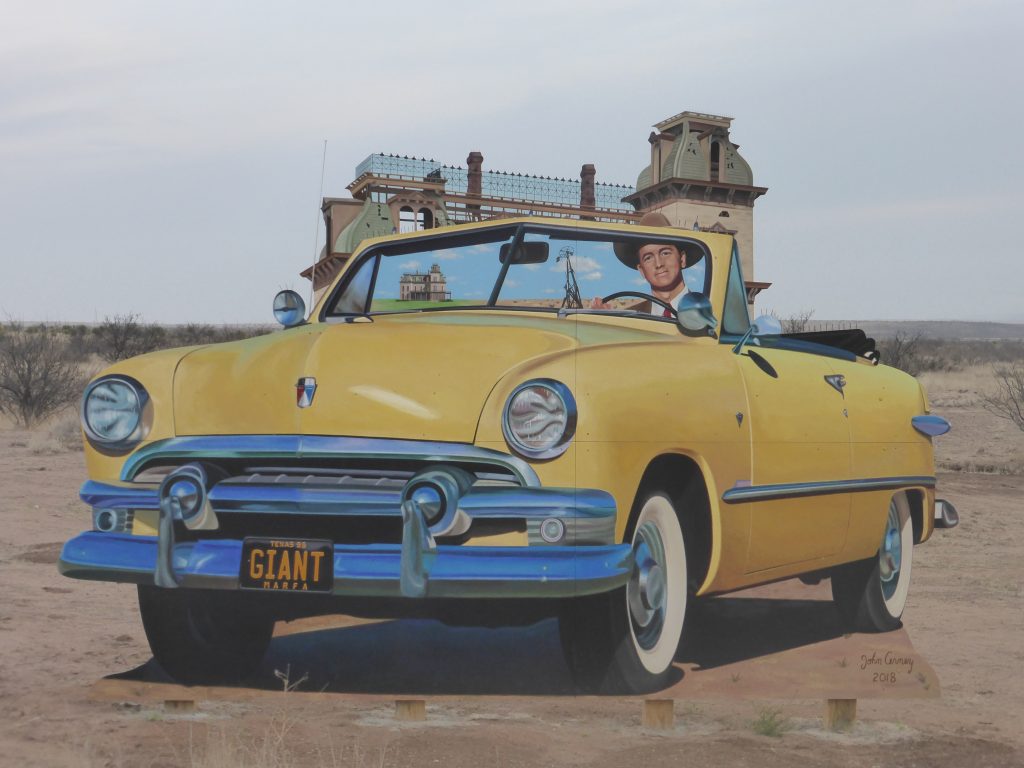
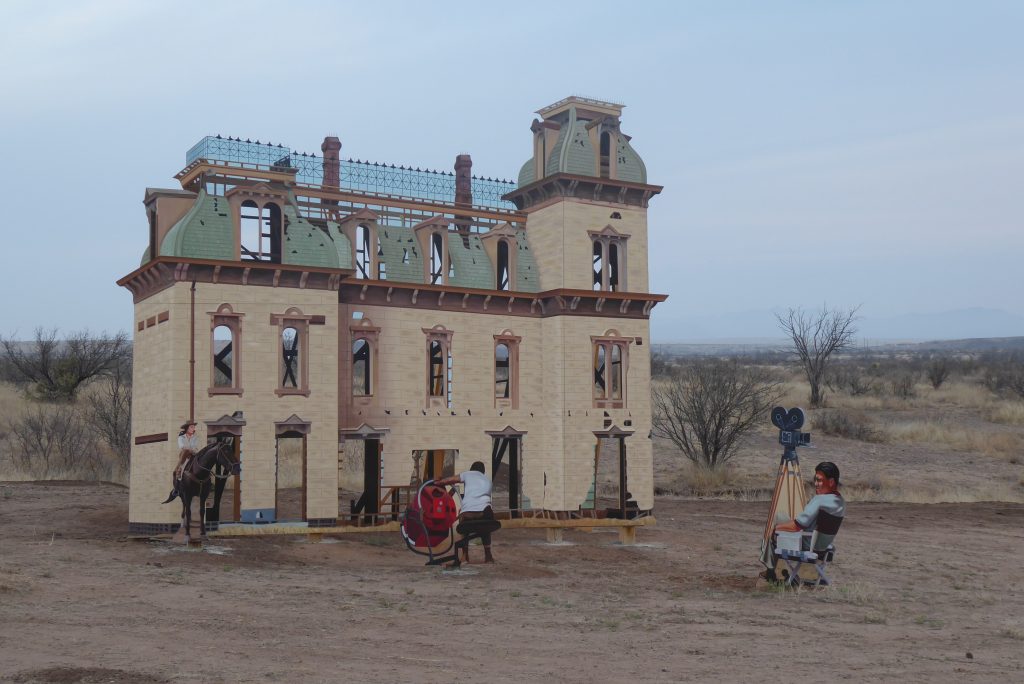
We’d seen photographs from the film on display at the El Paisano Hotel and looking at the youthful image of James Dean it is still hard to believe this was his last ever film, indeed when he was killed in his Porsche Spider in September 1955 at the age of 24, ‘Giant’ had not even been edited.
“In the summer it transforms into lush green pastures, supporting thousands of cattle”.
This massive art installation is the work of mural artist John Cerney and even has a musical soundtrack – as if we are hearing Rock Hudson’s car radio – all played on hidden speakers powered by solar. A work of Marfa art.
Ryan Ranch, where some of the filming took place and we were now stood overshadowed by Liz and James, is vast and empty – an enormous plain of yellowish grass reaching into the distance, with sparse growths of bush, and surrounded by low mountains on all sides. In the summer it apparently transforms into lush green pastures, supporting thousands of cattle.
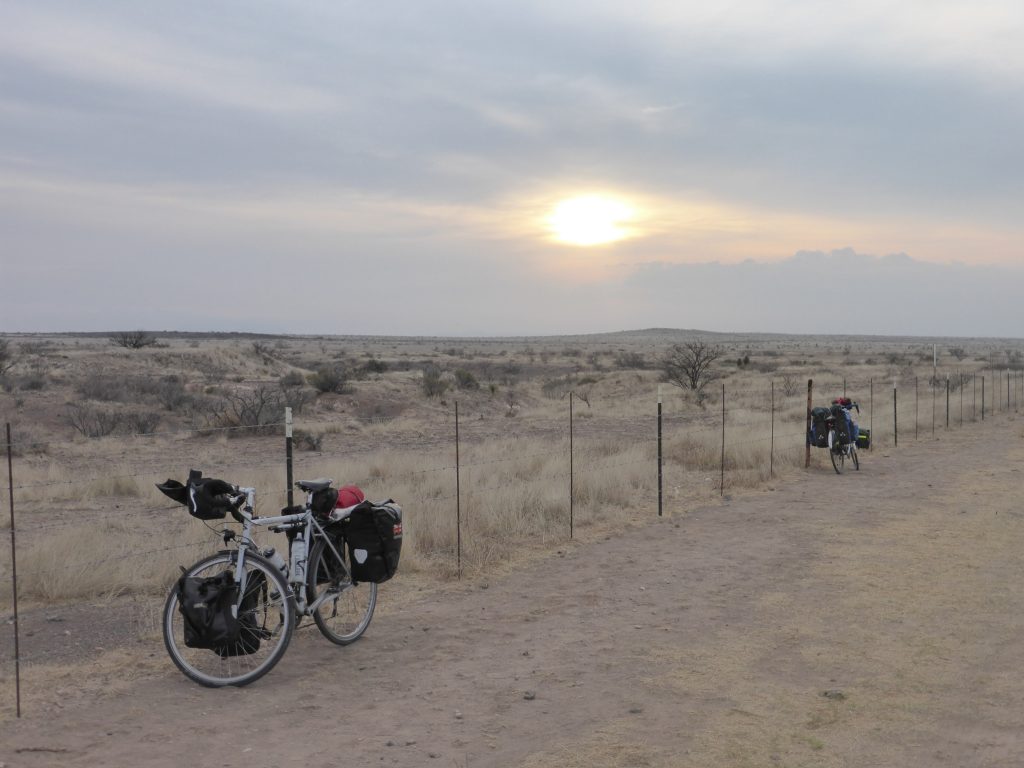
As the sound of Rock’s radio drifted into the distance, the soundtrack to our ride was the whistle of the wind behind us as it propelled us so fast we’d clocked up 20 miles before 9.15am – at this rate we’d be in Van Horn for lunch! But as usual there are always things to suck up the hours and it wasn’t long before we were distracted by a strange cigar shaped inflatable to our left.
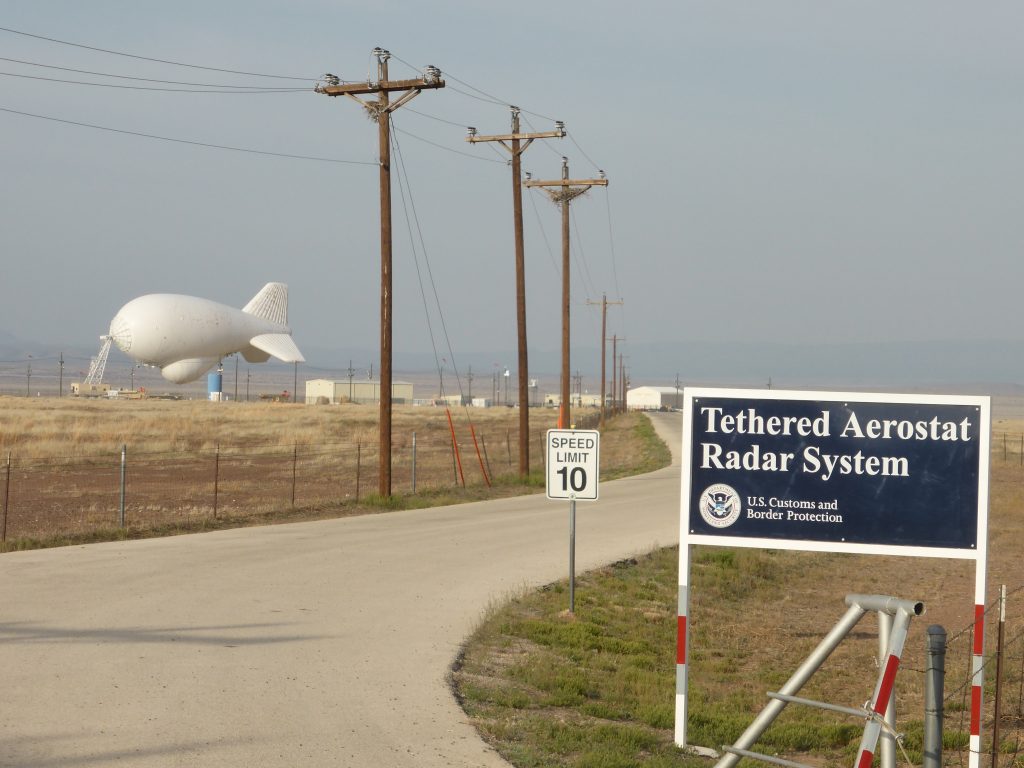
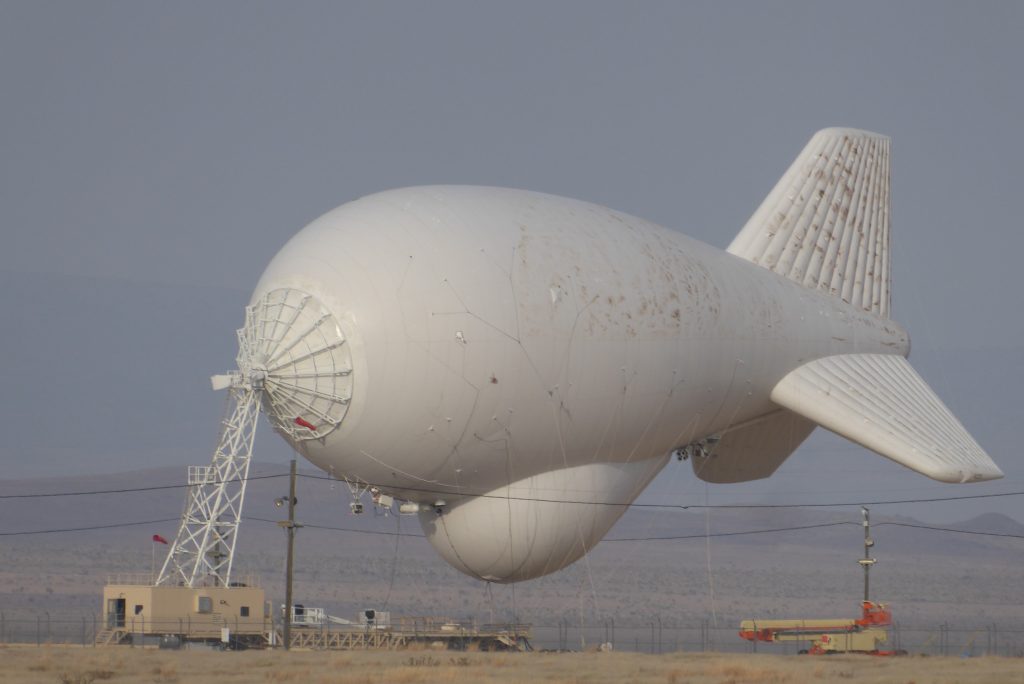
As we got closer we realised it was some kind of air balloon, tethered to the ground alongside a collection of buildings. A sign revealed it to be a Tethered Aerostat Radar System. This radar system uses moored balloons, which can be flown as high as 15,000 ft, as a radar platform, with their primary mission being to counter illegal drug trafficking. Since 2014 the system has been the responsibility of U.S. Customs and Border Protection. It was a reminder that the Mexican border is never far from us on this section of the ride.
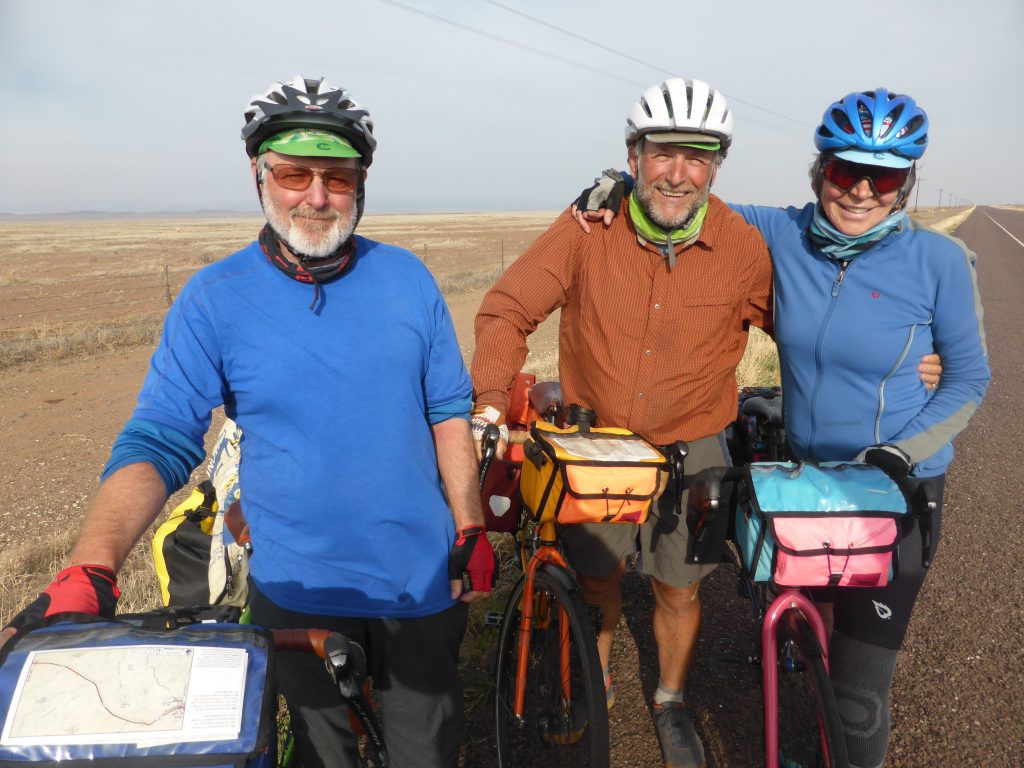
We weren’t the only ones fascinated by the blimp – a little further along the shoulder we came across retirees Randy, Sue and Mike, from Seattle, cycling east from San Diego to Florida and riding bikes that had been sprayed to match the colours of the ukuleles each of them was carrying, ready for impromptu jams along the route. They’d also gone off the ACA route because of predictions of snow around Phoenix, so had headed south via Tuscon.
They’d spent the night camped out behind the public library in Valentine and confirmed there was nothing in town, although there was a water spigot at the side of the building to top up drinking bottles. It was confirmation of what we’d been warned – there were effectively no services for 74 miles between Marfa and Van Horn with the store in Valentine shutting its doors many years ago. The trio were planning to overnight in Marfa. Sue was particularly interested to find out more about the airfield where her father had served in WW2.
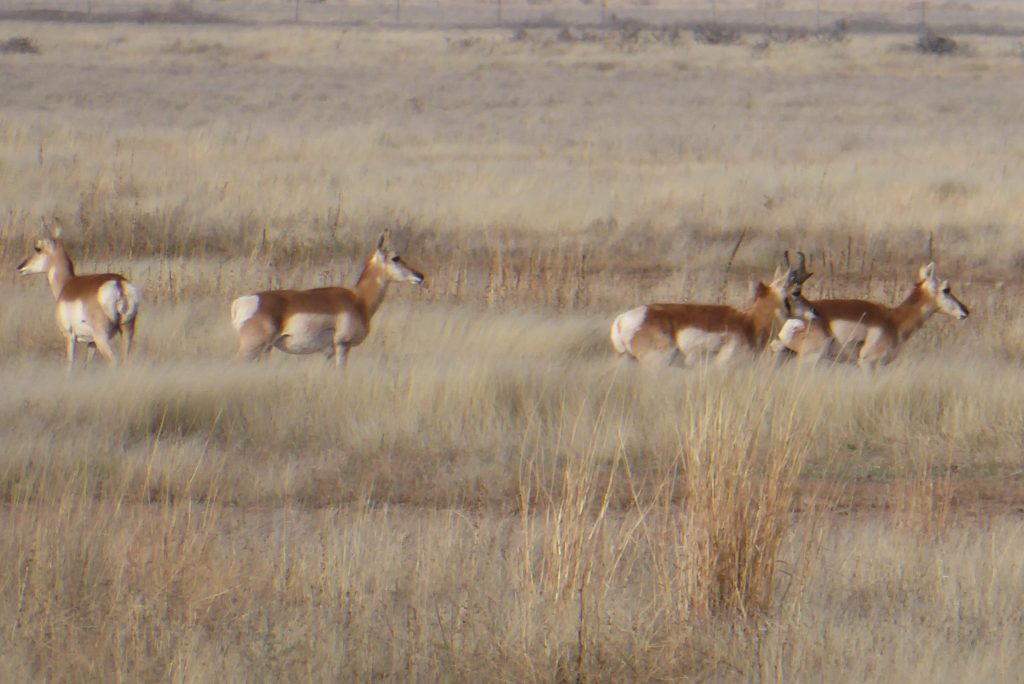
Although at first glance these plains can appear devoid of life, stopping and actually looking more carefully reveals quite a range of flora and fauna. Luckily we saw a couple of harriers quartering over a dry creek, a small herd of impala (that’s what the postcard in Marfa said they were, although we’ve always referred to them as pronghorns), hares, more roadrunners and several kinds of pipits.
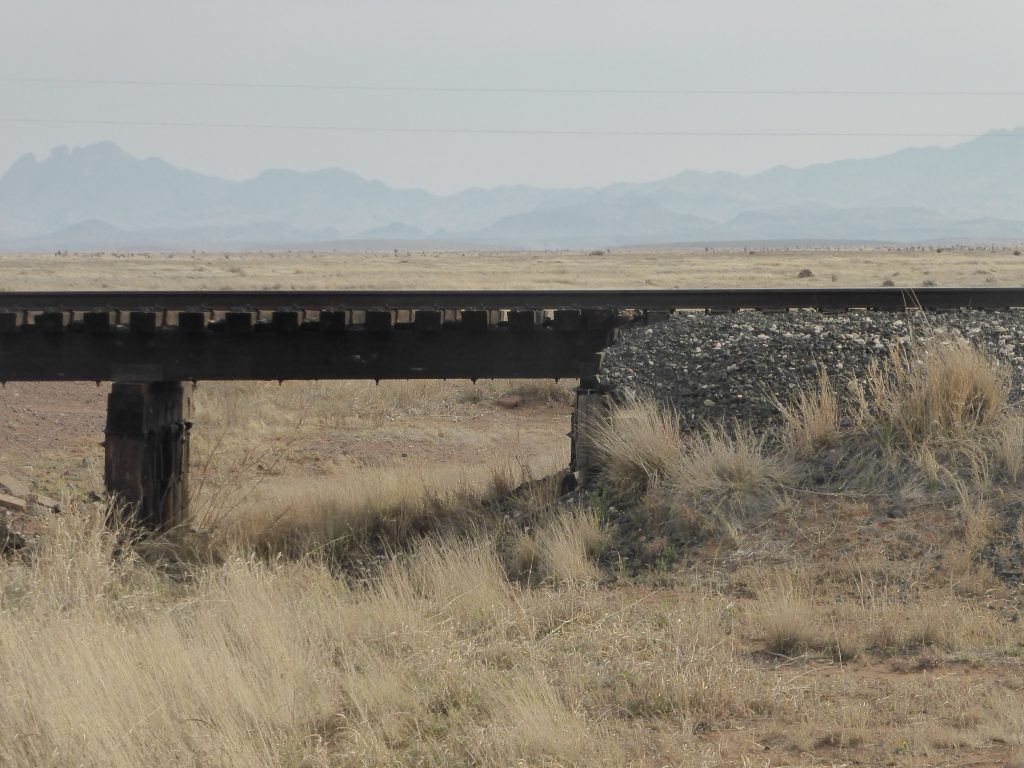
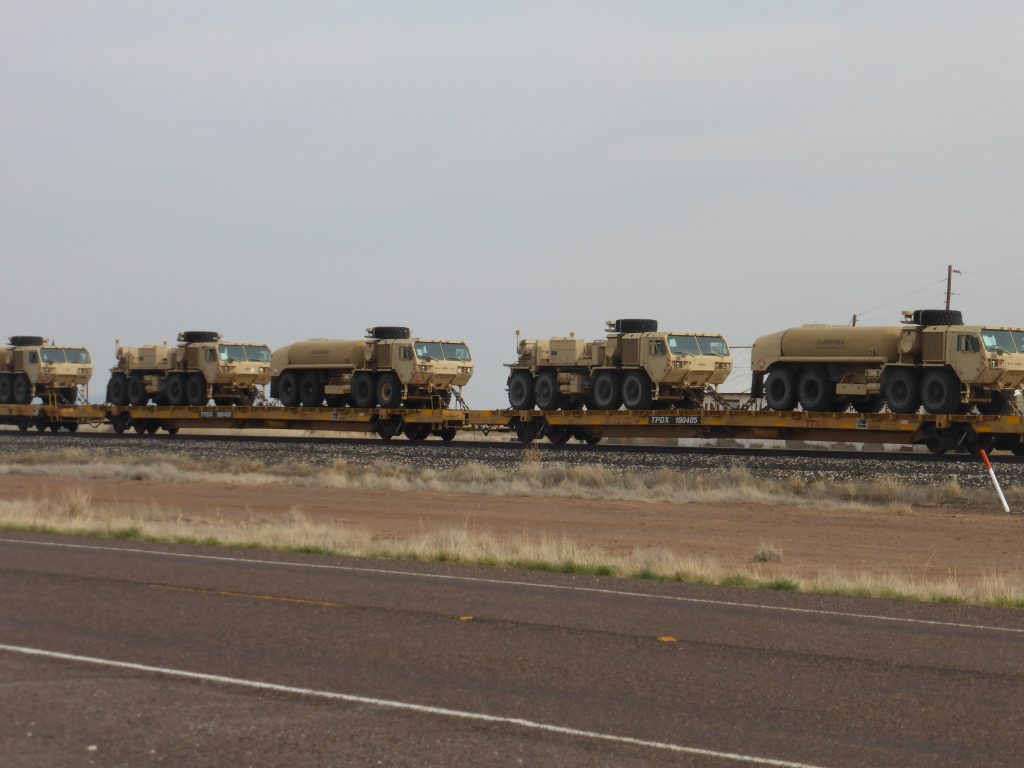

At 23 miles in we passed a significant milestone – we spotted our first tumbleweed, scuttling across the road in front of us. There’s something uniquely other worldly about these travelling plants – nomadic flora catching a ride on the wind until an obstacle like a bridge or wall proves unsurpassable and scores of them pile up in a log jam, going nowhere until the wind turns turtle.

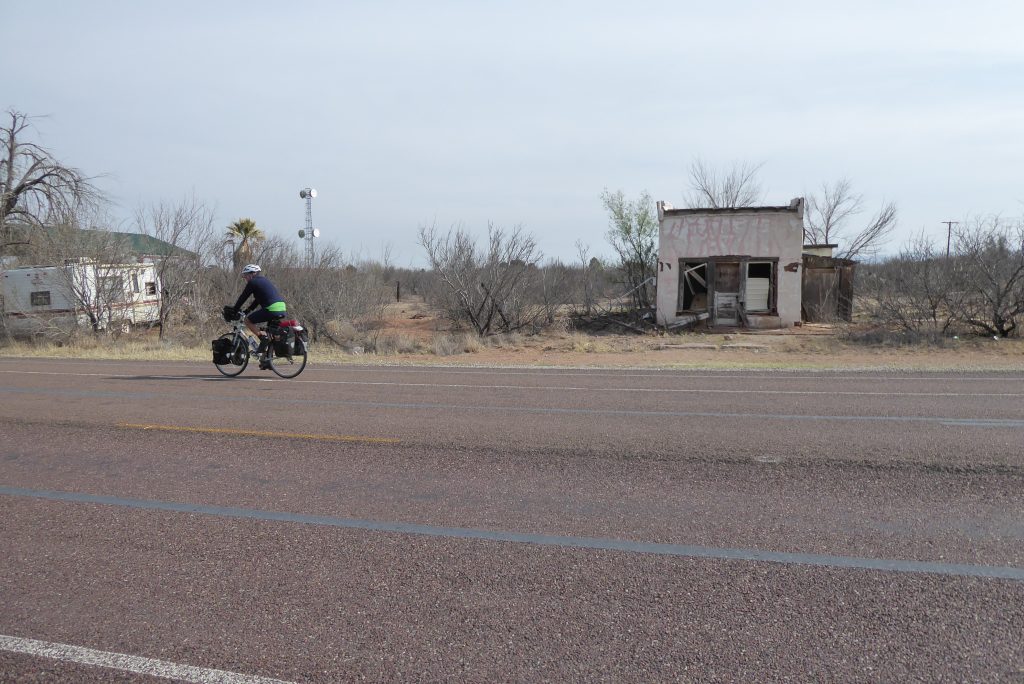
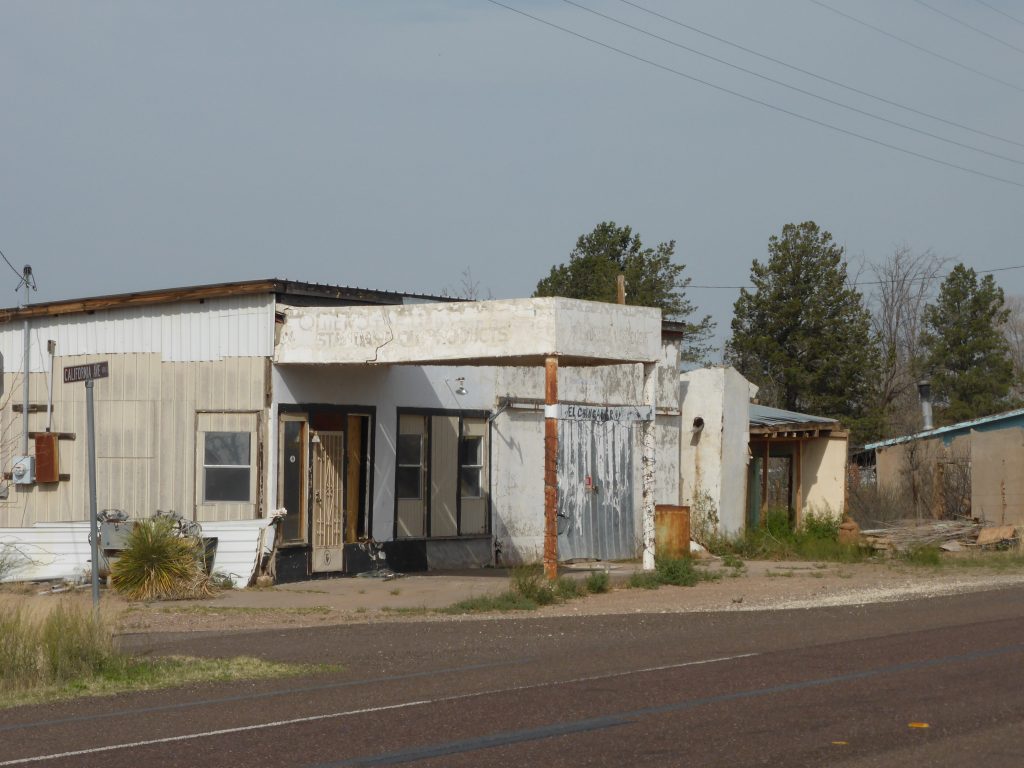
Valentine proved to be just about as desolate as everyone had described. Shut up businesses, dilapated houses and general scenes of abandonment. Which is why the public library, based in one of the few standing houses, was a real surprise. Peering through the front door we could see shelves of neatly stacked books. But despite a notice saying it was open, no-one responded to our knocks on the door apart from a small yappy dog that would have been squashed flat if one of the volumes had taken a tumble.

We found the water spigot around the corner then sat at a bench next to a large square of astroturf and ate an early lunch of bananas, kiwi and trailmix before doing a spot of exploring. The town had grown up around the railway and had once been an important watering stop for steam trains passing through. But with the advent of diesel in the 60s everything had gone off the rails.
“It seems the sole purpose the town now serves is to provide a novelty for lovers, who visit the Post Office in mid February to get a ‘Valentine’ postmark on their card”.
Those businesses that had not closed already finally died a death and it was hard to believe why anyone would still choose to live there. It’s been a familiar theme in the part of Texas we’ve been cycling through … the railway giveth, and then the railway taketh away.
It seems the sole purpose the town now serves is to provide a novelty for lovers, who keen to express their affections, visit the Post Office in mid February to get a ‘Valentine’ post mark on their card.
Take it from me, if you ever receive a card with a Valentine stamp on it then run for the hills. Anyone who makes the effort to drive out to this deserted wasteland is either seriously unhinged or infatuated with you to the point of obsession. It’s time to make like a tumbleweed and get out of town – fast.



The hub of the town had once been the Mercentile Store, opened in 1907, but closed in the 60s. An information board outside the library showed an old black and white photo with three Tin Lizzies parked up outside. Wandering through the scrub we found the store on the other side of the railway line, abandoned, but not entirely unloved. Although empty and needing repair, some work had recently been done on the building, which features pressed tin claddings adorning its adobe construction.
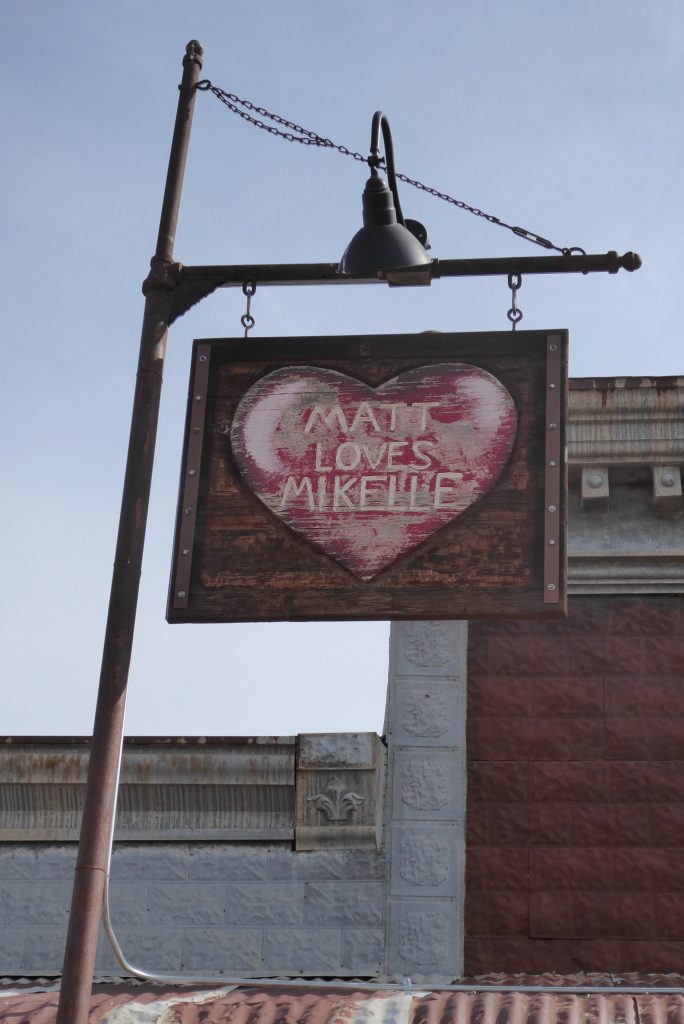
Just as we were leaving Valentine we spotted a cafe on the left hand side, clearly open and selling coffee. No-one we had spoken to had mentioned this and we wondered if most people had just not spotted it, too distracted by the dilapidated buildings around it. We contemplated stopping, but it was too late and we were desperate not to lose the advantage of the tailwind so we decided to love and leave Valentine for good.
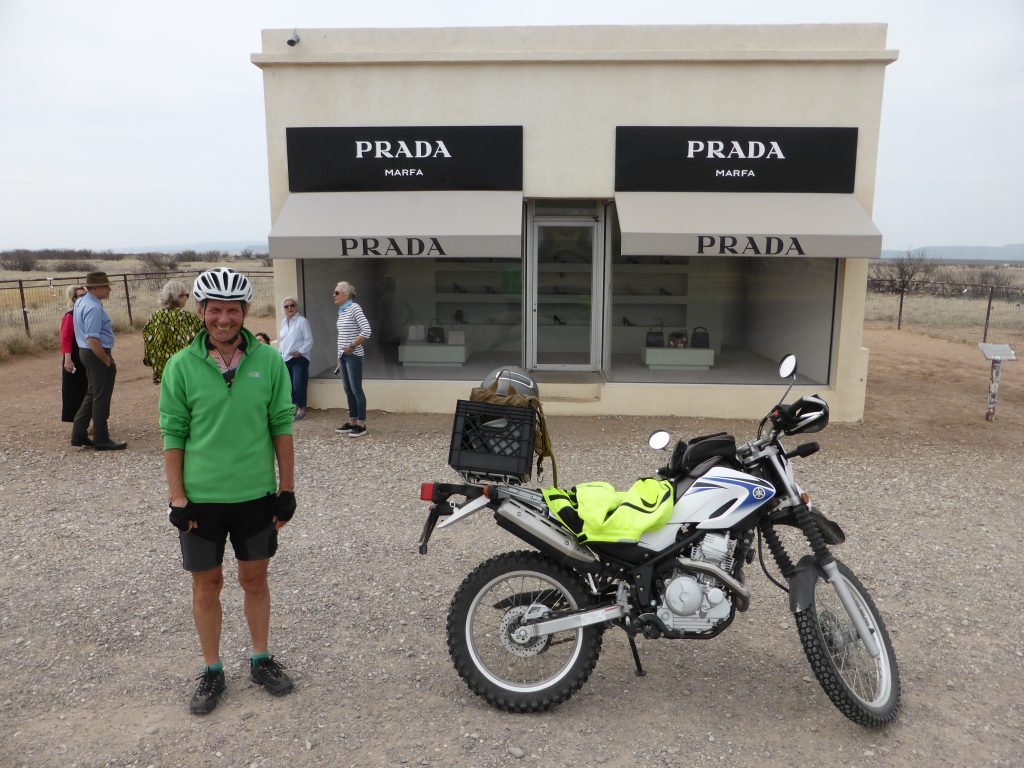
And then, cycling out of Valentine and back into the barren desert, we passed possibly the most random building of the entire ride – a Prada shop. On its own. In the middle of nowhere. By the side of the road. With a shop window displaying ladies high heeled shoes (all singles) and luxury handbags. Now that’s weird, even for Texas. It’s actually an art installation commissioned by Art Production Fund and Marfa Ballroom … an international art collective … built in 2005, and with real Prada shoes, but with the door permanently locked.
Terry, who knows a thing or two about art, loved it and got it on lots of levels I couldn’t even comprehend. With my artistic training limited to painting by numbers, I just didn’t get it. I could see that it was trying to get across the pointlessness of designer brands in this desolate landscape, but surely the money would have been much better spent building a real shop, complete with fruit and veg, for the few remaining inhabitants of Valentine?
Various people were gathered around the building, but any chance of a photo showing its desolation were scuppered by a scrambler motorbike parked directly in front of it. It turned our the rider, a rather glamorous looking young woman, was taking part in a world record attempt with women motorcyclists all over the globe biking an international relay.
As we left the Prada store behind a deep discussion ensued between us for the next ten miles or so on what is art … in all its forms … and it’s relative merits. I’ve always been hugely impressed by Terry’s artisitic abilities and knowledge and his incredible use of colours. His eighteenth Century house in Norwich features an acid green front door, which just shouldn’t work, but it looks brilliant. If I tried to do something similar it would look ridiculous – I just don’t have an artisitic eye and he was unable to make me understand what was so great about the Prada, Marfa. Philistines like me, as Terry found out, are hard to convert.
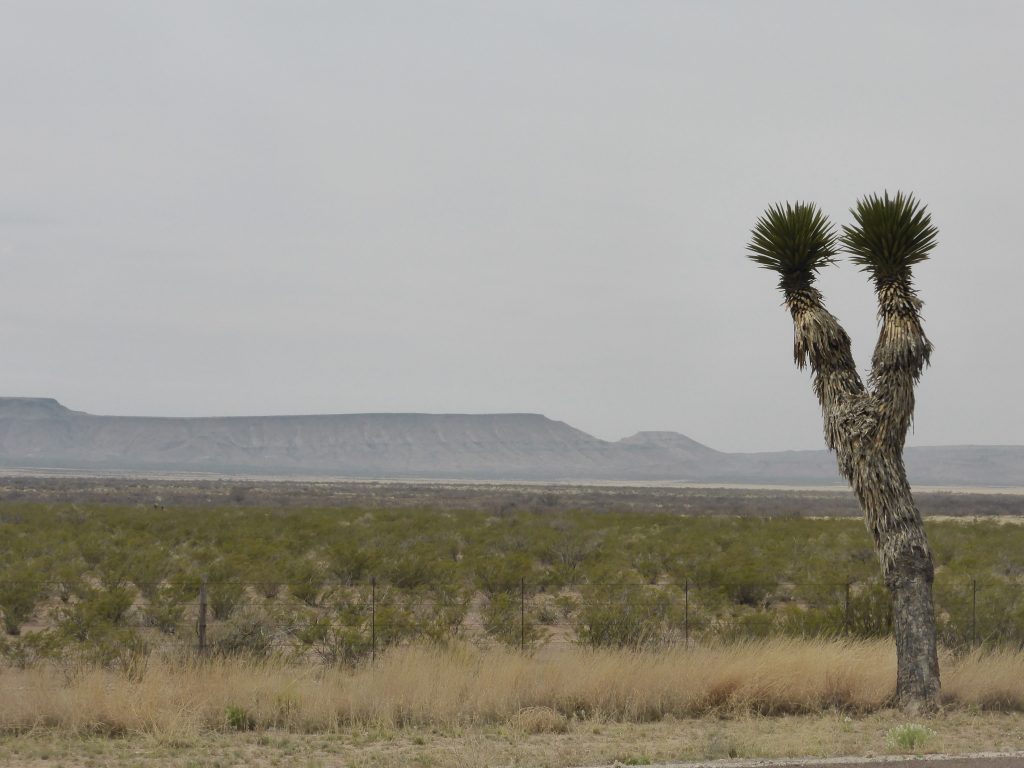
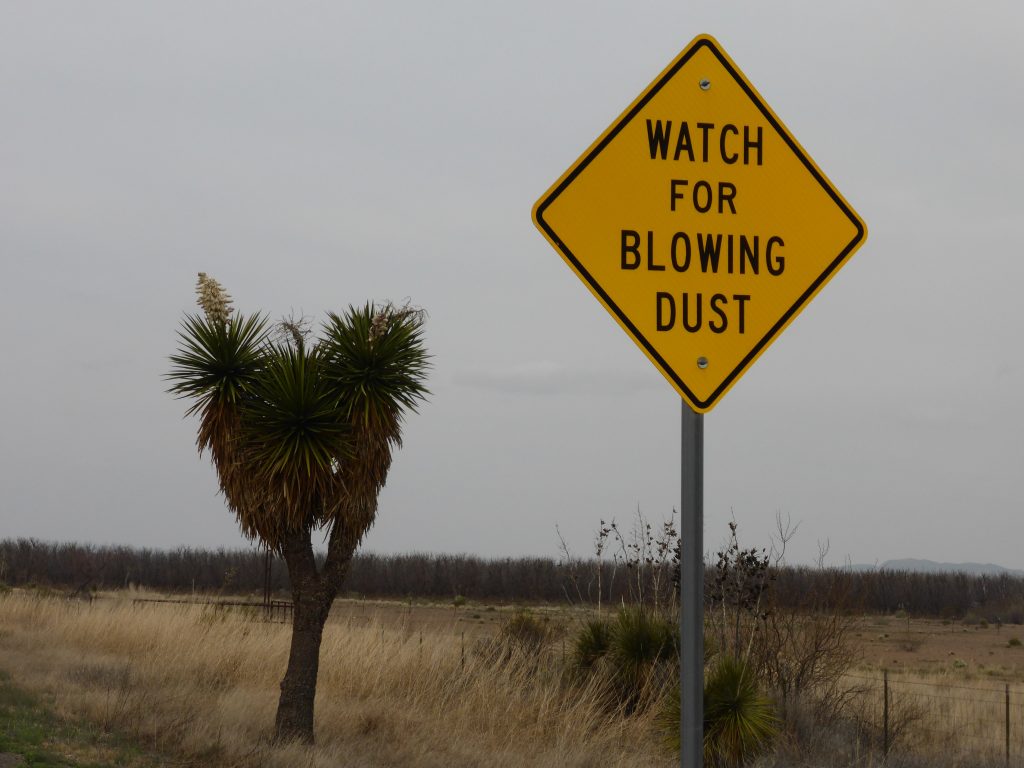
We spent the rest of the day riding across a large plain with the Davis Mountains in Texas to our right (the highest peak being Mount Livermore) and the Sierra Madre Oriental mountain range across the Mexican border to our left.
By the time we reached our final ten miles my legs were shot. Terry pulled ahead and I found him sitting on the curb at the first gas station going into Van Horn. I must have been tired as I seem to have missed the vast pecan plantation that Terry had spotted to our right, with the road to our left remaining scrub. A historical marker explained it all: this area has ‘weeping springs’ that bring water up to near the surface and this geological quirk had been utilised by native Indians for thousands of years. The moisture is very localised and the agriculture stopped as quickly as it started, returning to infertile soil and more scrub.
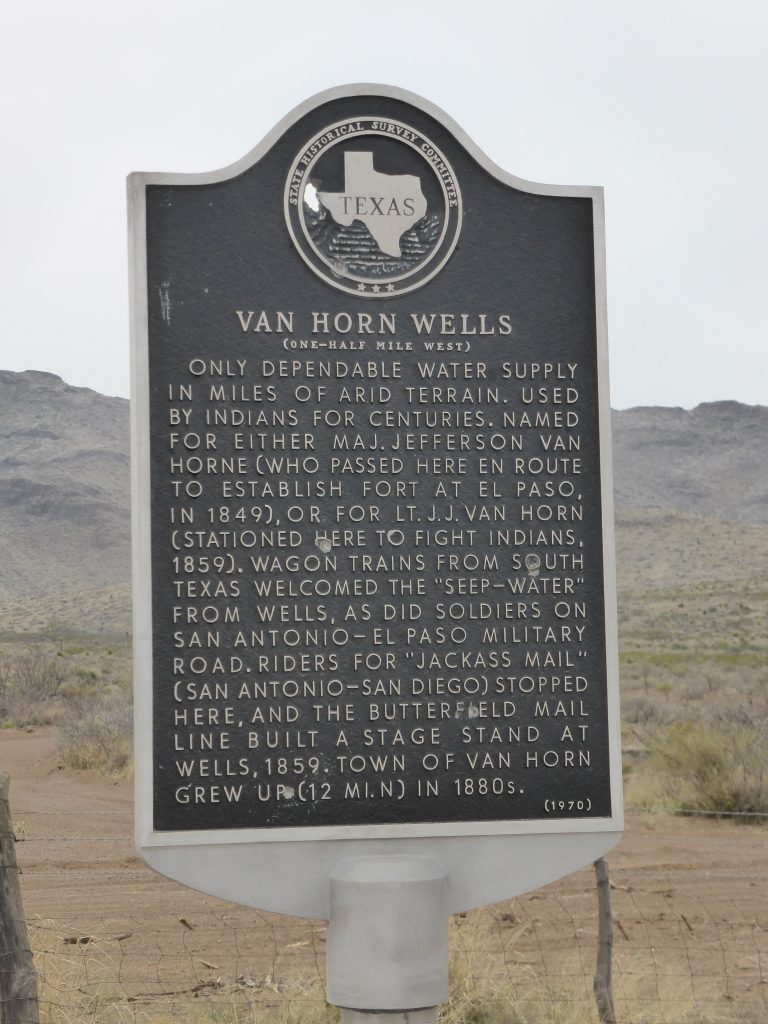
We were at our destination, we’d done nearby 75 miles and it was only 3.15pm. We searched in vain for a decent coffee shop, but the only one we found had just shut. The owner, sitting in his car, apologised. He’d just closed the doors to pick up his son from school.
Van Horn appeared to be just one long strip of motels, car repair shops and closed restaurants and with all the RV sites seemingly nestling between the 90 and the thundering traffic on Interstate 10 it didn’t take much to make us choose the Motel 6 and a spot of comfort – including some coffee from reception. Picking up supplies from the store next door we crashed for a few hours (in my case falling fast asleep sitting upright on the bed) before the luxury of microwave meals and steamed veg. Another 70 plus day tomorrow and may the wind be with us!
Today’s miles: 75.74
Miles since Anastasia State Park: 1,952.19


